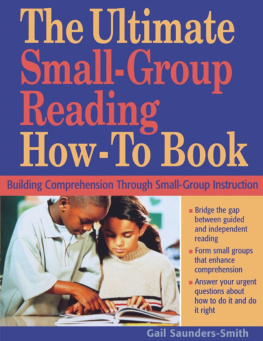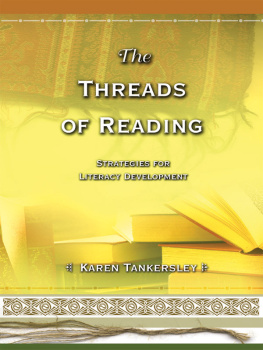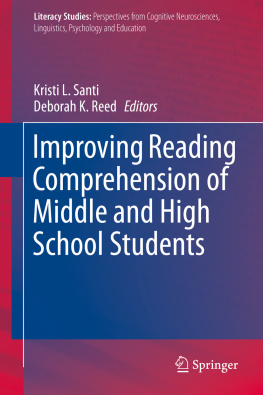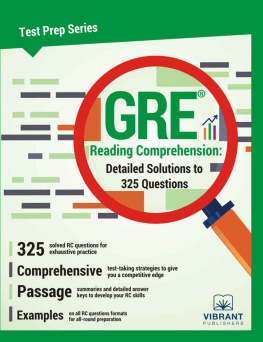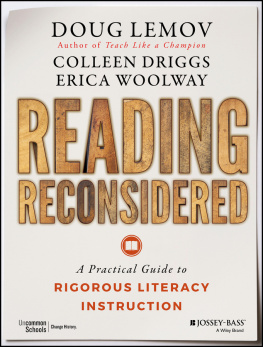Do I Really Have to Teach Reading?
Content Comprehension, Grades 612

Stenhouse Publishers
www.stenhouse.com
Copyright 2004 by Cris Tovani
All rights reserved. Except for the appendix forms that may be photocopied for classroom use, no part of this publication may be reproduced or transmitted in any form or by any means, electronic or mechanical, including photocopy, or any information storage and retrieval system, without permission from the publisher.
Every effort has been made to contact copyright holders and students for permission to reproduce borrowed material. We regret any oversights that may have occurred and will be pleased to rectify them in subsequent reprints of the work.
Credits
Page 8: From The Demon in the Freezer by Richard Preston, copyright 2002 by Richard Preston. Reprinted with permission of Random House, Inc.
Page 30: From Integrated Mathematics, Book 2 by Rheta N. Rubenstein, Timothy V. Craine, and Thomas R. Butts. Copyright 2002 by McDougal Littell, a division of Houghton Mifflin Company. All rights reserved. Reprinted by permission of McDougal Littell, a division of Houghton Mifflin Company.
Page 48: Using Nonfiction Genres to Promote Science Practices by Margaretha Ebbers, in Language Arts. Copyright 2002 by the National Council of Teachers of English. Reprinted with permission.
Page 64: From Letters to the Editor. Time. October 28, 2002. Reprinted with permission.
Page 73: Jennifer Mooney, Littleton Library Patron, 12, Pleads Guilty. The Denver Post July 12, 2002. Reprinted with permission.
Page 76: Copyright 2003 by BuddyT (http://alcoholism.about.com/), licensed to About Inc. Used by permission of About Inc., on the Web at http://www.about.com. All rights reserved.
Page 77: From The Winter Room by Gary Paulsen, copyright 1989 by Gary Paulsen. Reprinted by permission of Orchard Books, an imprint of Scholastic, Inc.
Page 78: From Glencoe Physical Science copyright 2002, by Glencoe/McGraw-Hill. Reprinted with permission.
Page 120: Did I Miss Anything? from Ill Be Right Back by Tom Wayman, copyright 1997. Reprinted with permission of Ontario Review Press.
Library of Congress Cataloging-in-Publication Data
Tovani, Cris.
Do I really have to teach reading?: content comprehension, grades 612 / Cris Tovani.
p. cm.
Includes bibliographical references.
ISBN 1-57110-376-7 (alk. paper)
1. Content area reading. 2. Reading (Middle school) 3. Reading (Secondary) I. Title.
LB1050.455.T69 2004
428.40712dc22 2003065348
Published simultaneously in Canada by
Pembroke Publishers
538 Hood Road
Markham, Ontario L3R 3K9
Pembroke ISBN 1-55138-170-2
Manufactured in the United States of America on acid-free paper
10 09 08 07 06 05 04 9 8 7 6 5 4 3 2 1
For Pete, who helps me sing my life song
Contents
Acknowledgments
When I leave Colorado to do presentations, I am often asked how I do it. Teachers want to know how I can still be in the classroom, write books, and travel to work with other teachers. I tell them I can do what I do only if I give up something. I mention that I dont cook well. As a matter of fact, the best thing I make is reservations. I have messy cupboards and drawersout of sight, out of mind. I dont iron. My garden is an embarrassment, and I buy Christmas cookies instead of making them. However, the real truth is I do what I do because:
My high school principal, Jeannine Brown, supports my work. She insulates me from tasks that take me away from teaching. She listens to my concerns and works very hard to accommodate instructional needs.
I have challenging students who share their thinking. Their questions propel me to discover why reading is so easy for some and so difficult for others.
My editor Brenda Power has a magic touch. Her ability to organize my random thoughts into a cohesive book astounds me. At Stenhouse, I can always depend on Philippa Stratton, Tom Seavey, and Martha Drury to answer questions and guide my work.
Stephanie Harvey encourages me to look outside my comfort zone and notice whats provocative in the field of education.
Ellin Keene challenges me to find a better way to teach adolescents how to read.
I learn from the visitors who observe my classroom and if I didnt have Sam Bennett and Chryse Hutchins naming the thinking and guiding the learning, I wouldnt be able to take the risks it requires to teach in front of my peers.
My colleagues at Smoky Hill High School push me to think. Their content expertise humbles me. Their willingness to open their doors reminds me how important it is to never stop learning.
For this particular book, Winter Caplanson, Sarah Malinoski, Ruth Shagoury, Lee Ann Spillane, and Suzanne Kaback read early drafts and provided direction for revision.
Rhiannon and Sara teach me that works in progress are worth the wait.
And the real truth is, none of this could happen without the support of my husband, Pete, who helps with the cooking and cleaning and car pooling. He encourages me and believes in me whenever Ive lost faith. Without him none of this would be possible.
Last and most important, I have Carrie, who is the inspiration for everything I do.
1
Introduction: Im the Stupid Lady from Denver
The science textbook is hard for me to read. It has a lot of information with diagrams and pictures. All of these things are helpful to people who know the subject, but to me it is very confusing.
Evan, high school junior
Its a rainy Monday morning. I am sitting by an open window in a California high school science classroom, far away from my own students in Denver. I watch as students file in and fill the seats. I overhear a conversation between two girls:
What are we doing today?
Remember? The stupid lady from Denver is coming to teach us about reading.
I realize they are talking about me, and the butterflies in my stomach flap a bit faster. Ive been hired for the day to work at an alternative high school. My morning will consist of doing demonstration lessons in content-area classrooms, with the afternoon spent debriefing the lessons and sharing comprehension instruction with the teachers who are observing.
The stakes are high, with much expected of me. Teachers have been provided with substitutes so that they can come and watch the demonstrations. The principals hope is that the teachers will learn how to help students be better readers of their content.
My first demonstration lesson is in this science classroom. The biology course is a graduation requirement, and the students taking the class are struggling readers who will most likely not be going to college. Much to my displeasure, I am to use the textbook chapter on viruses. I received the chapter earlier in the week, but had trouble getting through it. It is long, boring, and difficult to read.
It is challenging for me to plan these types of lessons, but I always request the actual textbook or reading materials in advance so that I can see the work from both the teachers and the students perspectives. I dont know the students, and Im not an expert in the content. In this case, my ability to read the virus chapter closely resembles that of the students.
Sometimes not knowing the content well benefits me. My job is not to teach the contentthats the classroom teachers job. My job is twofold. First, I am supposed to model a strategy that will help students become better readers of science. Second, I am supposed to model for the teachers a strategy that works not only with a specific chapter, but with all kinds of reading.




